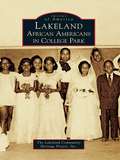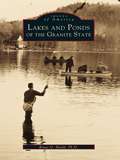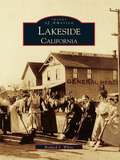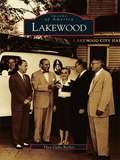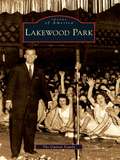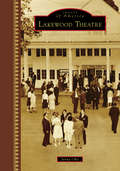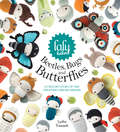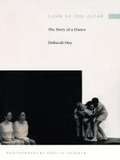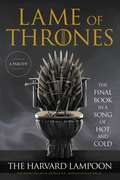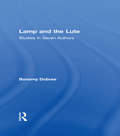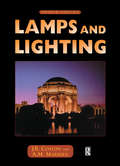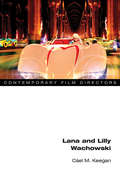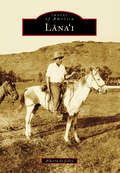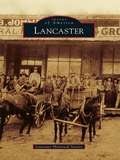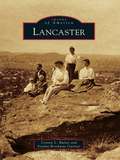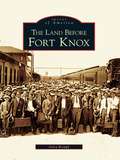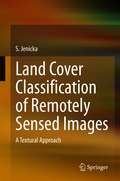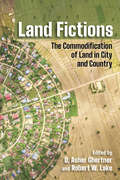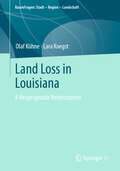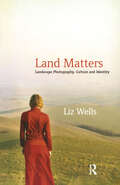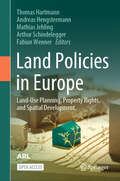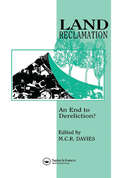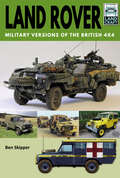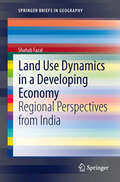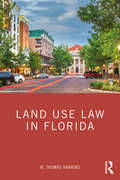- Table View
- List View
Lakeland: African Americans in College Park (Images of America)
by The Lakeland Community Heritage Project, Inc.Lakeland, the historical African American community of College Park, was formed around 1890 on the doorstep of the Maryland Agricultural College, now the University of Maryland, in northern Prince George's County. Located less than 10 miles from Washington, D.C., the community began when the area was largely rural and overwhelmingly populated by European Americans. Lakeland is one of several small, African American communities along the U.S. Route 1 corridor between Washington, D.C., and Laurel, Maryland. With Lakeland's central geographic location and easy access to train and trolley transportation, it became a natural gathering place for African American social and recreational activities, and it thrived until its self-contained uniqueness was undermined by the federal government's urban renewal program and by societal change. The story of Lakeland is the tale of a community that was established and flourished in a segregated society and developed its own institutions and traditions, including the area's only high school for African Americans, built in 1928.
Lakes and Ponds of the Granite State (Images of America)
by Bruce D. HealdNature chose to endow New Hampshire with an infinite variety of lakes and ponds, almost inexhaustible in resources and unlimited in beauty. Each lake holds its own fishing secrets, curving nooks, jagged rocks, and intricate shoreline. For generations, the lakes and ponds have wielded their magnetic force,attracting thousands of residents and visitors in every season of the year. Lakes and Ponds of the Granite State invites you to explore the many wonders of these charmed places. You will see the sun glancing off the wind-flecked surface, hear the breeze rustle the shoreward-bending trees, feel the coolness of the water, and eye a prized trout or two. You will encounter not only those lakes that come to mind first--Winnipesaukee, Sunapee, Squam, and Newfound--but nearly one hundred others, including Dublin and Spofford and the breathtaking Gloriette Lake.
Lakeside, California
by Richard S. WhitePurchased by the El Cajon Valley Land Company in 1886, Lakeside began as a small hamlet along the banks of the San Diego River. Home to the only natural lake in San Diego County, Lakeside offered visitors throughout the century a scenic backdrop for boating, fishing, hunting, riding, and hiking. Captured here in over 200 vintage images is the history of this town located just 25 miles east of San Diego. After the San Diego Mission was established in 1769, the Padres explored the backcountry, seeking grazing lands for their livestock. Following the San Diego River upstream they came to a broad valley, which they named El Cajon, "the box." In 1886, 6,600 acres were sold to the El Cajon Land Company for the Lakeside town site and a large inn was built as a resort. Due in large part to the trains coming through Lakeside in 1889, Lakeside had become a thriving community by the turn of the century.
Lakewood (Images of America)
by Thea Gallo BeckerNamed for its natural setting on the south shore of Lake Erie, Lakewood, Ohio was one of Cleveland's original suburbs. Incorporated as a city in 1911, Lakewood experienced tremendous growth during the early 20th century, and became known as "Cleveland's Fashionable Suburb," and a "City of Beautiful Homes," as it boasted some of the finest Victorian residences in the area. Using a wonderful collection of historic photographs, many from the Lakewood Historical Society, the pages of this book take you on a tour of Lakewood's history, chronicling the people, places, and events that have made the suburb one of the area's best places to live.
Lakewood Park (Images of America)
by The Guinan FamilySituated in the coal regions of northeast Pennsylvania, Lakewood Park was established in 1916 by the Guinan family as a place to bathe, picnic, and camp. It became known as a nature retreat for the nearby miners and their families, and it developed into the destination for swimming, amusement rides, skating, big band dances, boxing matches, ethnic celebrations, summer stock plays, and political banquets. The park boasted a 150-yard cement pool, hand-carved Spillman carousel, and grand ballroom. It was the host of the longest-running ethnic festival in Pennsylvania, Lithuanian Day, from 1914 to 1984. Using vintage images, Lakewood Park recalls the various festivals and celebrations, amusements rides, and celebrity performers, such as Dick Clark and Doris Day, that made the park an entertainment mecca for 68 years.
Lakewood Theatre (Images of America)
by Jenny ObyBeginning as a humble vaudeville hall in the Skowhegan-Madison trolley park, Lakewood Theatre has graced the southwestern shore of Lake Wesserunsett in Madison, Maine, since the turn of the 20th century. Under the masterful guidance of Herbert L. Swett, a Bangor native and Bowdoin graduate, Lakewood eventually developed into a nationally renowned playhouse that was called the “Broadway in Maine” by the New York Times in its heyday, from 1925 until World War II. In the years following the war, Lakewood was operated by Swett’s heirs and became a virtual who’s who of both Broadway and Hollywood, until it nearly went dark in the early 1980s. Operating today as a nonprofit community theater, Lakewood is the official state theater of Maine and the oldest continually running summer theater in the country.
Lalylala's Beetles Bugs and Butterflies: A Crochet Story of Tiny Creatures and Big Dreams
by Lydia TresseltHello bug lovers and crochet adventurers! Grab your research equipment (magnifying glass, flask of tea, crochet hook, scissors and yarn) and follow us into a world full of magic and science, a microcosm of tiny creatures and big dreams! In this book you will find not only a charming selection of crochet patterns to create scrabbling beetles, beautiful bugs and fluttering butterfly crochet amigurumi, but also a wonderful story to read out loud and ponder on: a tale about growing up; accepting change and the power of dreams. Watch tiny creatures hatching from their eggs, look on as they munch through a green world, and be astonished at their marvelous transformations when they finally slip out of their cocoons. The wings and hats are interchangeable so you can use the patterns in this book to create new outfits for your little insect friends. Give your caterpillar a new set of wings for every day of the week, or cover your beetle in the most colourful wing suits. Be inspired by nature to make creatures of your own creation. It's a great little world full of possibilities. We wish you lots of fun on your journey of discovery and learning!
Lamb at the Altar: The Story of a Dance
by Deborah Hay"The intention of my work is to dislodge assumptions about the fixity of the three-dimensional body."--Deborah HayHer movements are uncharacteristic, her words subversive, her dances unlike anything done before--and this is the story of how it all works. A founding member of the famed Judson Dance Theater and a past performer in the Merce Cunningham Dance Company, Deborah Hay is well known for choreographing works using large groups of trained and untrained dancers whose surprising combinations test the limits of the art. Lamb at the Altar is Hay's account of a four-month seminar on movement and performance held in Austin, Texas, in 1991. There, forty-four trained and untrained dancers became the human laboratory for Hay's creation of the dance Lamb, lamb, lamb . . . , a work that she later distilled into an evening-length solo piece, Lamb at the Altar. In her book, in part a reflection on her life as a dancer and choreographer, Hay tells how this dance came to be. She includes a movement libretto (a prose dance score) and numerous photographs by Phyllis Liedeker documenting the dance's four-month emergence.In an original style that has marked her teaching and writing, Hay describes her thoughts as the dance progresses, commenting on the process and on the work itself, and ultimately creating a remarkable document on the movements--precise and mysterious, mental and physical--that go into the making of a dance. Having replaced traditional movement technique with a form she calls a performance meditation practice, Hay describes how dance is enlivened, as is each living moment, by the perception of dying and then involves a freeing of this perception from emotional, psychological, clinical, and cultural attitudes into movement. Lamb at the Altar tells the story of this process as specifically practiced in the creation of a single piece.
Lame of Thrones: The Final Book in a Song of Hot and Cold
by The Harvard LampoonFrom Harvard's legendary humor publication comes an outrageous, uproariously funny parody of Game of Thrones, in the tradition of their previous bestselling parody book classics Bored of the Rings, Nightlight, and The Hunger Pains.An affectionate but take-no-prisoners send-up of the massive literary and television franchise, Lame of Thrones offers fans a way of reentering the fictional world they have come to love and merrily explodes all of its conventions -- as well as their expectations of the characters -- to hilarious ends. It may even leave you more satisfied than the actual TV ending of Game of Thrones. In fact, if it doesn't the Lampoon has really dropped the ball. Lame of Thrones will take you to Westopolis, where several extremely attractive egomaniacs are vying to be ruler of the realm and sit on the Pointy Chair. Our hero Jon Dough was a likely bet, but his untimely murder at the hands of his own men of the Night's Crotch has made that seem less likely. Will Dragon Queen Dennys Grandslam escape from her Clothkhaki captors and return to conquer the world? Or will she just get left in the desert counting grains of sand for the rest of the book? And what about Jon Dough's siblings? Will they be mentioned? Probably? Almost definitely, yes? It would be weird if they weren't prominent characters in the book, you say?To find out, read the book you wish George R.R. Martin would write but never will. The Lampoon -- the place where such comedy writers and performers as Conan O'Brien, Colin Jost, B.J. Novak, Patricia Marx, Alan Yang, Andy Borowitz and many more all got their start -- is ready to serve parody notice to the most entertaining, infuriating, and inescapable cultural phenomenon of the past decade.
Lamp and the Lute: Studies in Seven Authors
by Bonamy DobreeFirst Published in 1964. Routledge is an imprint of Taylor & Francis, an informa company.
Lamps and Lighting
by M.A. CaylessThis book is a comprehensive guide to the theory and practice of lighting. Covering the physics of light production, light sources, circuits and a wide variety of lighting applications, it is both suitable as a detailed textbook and as thoroughly practical guide for practising lighting engineers. This fourth edition of Lamps and Lighting has been completely updated with new chapters on the latest lamp technology and applications. The editors ahve called upon a wide range of expertise and as a result many sections have been broadened to include both European and US practice.The book begins with a description of the fundamentals of light, vision, colour and measurement. Part II, the main section of the book, deals with lamps and control equipment and includes descriptions of all lamp types in use today. Part III on lighting covers both interior and exterior applications.
Lana and Lilly Wachowski (Contemporary Film Directors)
by Cael M. KeeganLana and Lilly Wachowski have redefined the technically and topically possible while joyfully defying audience expectations. Visionary films like The Matrix trilogy and Cloud Atlas have made them the world's most influential transgender media producers, and their coming out retroactively put trans* aesthetics at the very center of popular American culture. Cáel M. Keegan views the Wachowskis films as an approach to trans* experience that maps a transgender journey and the promise we might learn "to sense beyond the limits of the given world." Keegan reveals how the filmmakers take up the relationship between identity and coding (be it computers or genes), inheritance and belonging, and how transgender becoming connects to a utopian vision of a post-racial order. Along the way, he theorizes a trans* aesthetic that explores the plasticity of cinema to create new social worlds, new temporalities, and new sensory inputs and outputs. Film comes to disrupt, rearrange, and evolve the cinematic exchange with the senses in the same manner that trans* disrupts, rearranges, and evolves discrete genders and sexes.
Lana'i
by Alberta De JetleyLong before neatly cultivated rows of pineapple fields stretched out as far as one could see, demon spirits are said to have made L?na'i uninhabitable for humans. The spirits were banished by a young man from L?haina who is credited with forming the first settlement on the island. Centuries later, in 1778, warriors battled on the island's steep cliffs and drove their enemies to their deaths. Every living thing was destroyed, all except for one man who saved himself by leaping off a cliff into the ocean and swimming to safety. Time heals, and the land endured. When winter storms turned barren slopes green again, the natives returned and were followed in later years by men who carved their names into the history of L?na'i.
Lancaster
by Lancaster Historical SocietyIn 1841, the Republic of Texas was on the brink of bankruptcy, and it needed to attract new immigrants in order to survive. With this important goal in mind, in 1844 the Texas congress authorized the republic's president, Sam Houston, to contract with individuals to colonize the state. In September of that same year, one group headed by Capt. Roderick Rawlins from Illinois came to Texas and settled in what would become the town of Lancaster. Farmers grew grains and cotton, and Lancaster became a trade center with a lively town square. A commercial club organized in order to coordinate advertising for local businesses, and it also held trade days that later became town fairs. Local residents worked hard all week and enjoyed horse races, baseball, "forty-two" parties, music performances, and other entertainment on the weekends. By the late 1800s, Lancaster was connected to the rest of the state by the railroads, but the town still retained its independent, small-town Texas character.
Lancaster (Images of America)
by Connie L. Rutter Sondra Brockway GartnerLancaster, Ohio, with a population of around 35,000, sits snuggled among the rolling hills at the base of a sandstone bluff that the Wyandot Indians called "Standing Stone." Just east of the Hock-Hocking River in Fairfield County and a few miles southeast of Columbus, Lancaster was founded on November 10, 1800, by Col. Ebenezer Zane (1747-1811). The city's rich history is celebrated today in one of the most significant historic districts in the Midwest, known as Square 13. The city offers a walking tour of the area, originally designed in 1800. In a 24-block area, 89 buildings have been designated on the National Register of Historic Places, and the Sherman House Museum is listed as a National Historical Landmark.
Land Before Fort Knox, The (Images of America)
by Gary KempfLocated south of the Ohio River and Louisville, Kentucky, the Fort Knox military installation is the location for the training of U.S. Army Armor and Cavalry forces. Known as the home of Mounted Warfare, Fort Knox is also the location of the U.S. Treasury Department Gold Vault that opened in February 1937. Fort Knox covers 178 square miles and spans parts of Hardin, Meade, and Bullitt Counties. The area was once home to Thomas Lincoln, father of the nation's martyred 16th president, as well as the burial place of Abraham Lincoln's grandmother, Bathsheba Lincoln. Images of America: The Land Before Fort Knox illuminates the past while images bring to light people and places of yesterday.
Land Cover Classification of Remotely Sensed Images: A Textural Approach
by S. JenickaThe book introduces two domains namely Remote Sensing and Digital Image Processing. It discusses remote sensing, texture, classifiers, and procedures for performing the texture-based segmentation and land cover classification. The first chapter discusses the important terminologies in remote sensing, basics of land cover classification, types of remotely sensed images and their characteristics. The second chapter introduces the texture and a detailed literature survey citing papers related to texture analysis and image processing. The third chapter describes basic texture models for gray level images and multivariate texture models for color or remotely sensed images with relevant Matlab source codes. The fourth chapter focuses on texture-based classification and texture-based segmentation. The Matlab source codes for performing supervised texture based segmentation using basic texture models and minimum distance classifier are listed. The fifth chapter describes supervised and unsupervised classifiers. The experimental results obtained using a basic texture model (Uniform Local Binary Pattern) with the classifiers described earlier are discussed through the relevant Matlab source codes. The sixth chapter describes land cover classification procedure using multivariate (statistical and spectral) texture models and minimum distance classifier with Matlab source codes. A few performance metrics are also explained. The seventh chapter explains how texture based segmentation and land cover classification are performed using the hidden Markov model with relevant Matlab source codes. The eighth chapter gives an overview of spatial data analysis and other existing land cover classification methods. The ninth chapter addresses the research issues and challenges associated with land cover classification using textural approaches. This book is useful for undergraduates in Computer Science and Civil Engineering and postgraduates who plan to do research or project work in digital image processing. The book can serve as a guide to those who narrow down their research to processing remotely sensed images. It addresses a wide range of texture models and classifiers. The book not only guides but aids the reader in implementing the concepts through the Matlab source codes listed. In short, the book will be a valuable resource for growing academicians to gain expertise in their area of specialization and students who aim at gaining in-depth knowledge through practical implementations. The exercises given under texture based segmentation (excluding land cover classification exercises) can serve as lab exercises for the undergraduate students who learn texture based image processing.
Land Fictions: The Commodification of Land in City and Country (Cornell Series on Land: New Perspectives on Territory, Development, and Environment)
Land Fictions explores the common storylines, narratives, and tales of social betterment that justify and enact land as commodity. It interrogates global patterns of property formation, the dispossessions property markets enact, and the popular movements to halt the growing waves of evictions and land grabs.This collection brings together original research on urban, rural, and peri-urban India; rapidly urbanizing China and Southeast Asia; resource expropriation in Africa and Latin America; and the neoliberal urban landscapes of North America and Europe. Through a variety of perspectives, Land Fictions finds resonances between local stories of land's fictional powers and global visions of landed property's imagined power to automatically create value and advance national development. Editors D. Asher Ghertner and Robert W. Lake unpack the dynamics of land commodification across a broad range of political, spatial, and temporal settings, exposing its simultaneously contingent and collective nature. The essays advance understanding of the politics of land while also contributing to current debates on the intersections of local and global, urban and rural, and general and particular.Contributors Erik Harms, Michael Watts, Sai Balakrishnan, Brett Christophers, David Ferring, Sarah Knuth, Meghan Morris, Benjamin Teresa, Mi Shih, Michael Levien, Michael L. Dwyer, Heather Whiteside
Land Loss in Louisiana: A Neopragmatic Redescription (RaumFragen: Stadt – Region – Landschaft)
by Olaf Kühne Lara KoegstThis book is oriented on testing and developing the neopragmatic approach of horizontal geographies, in which we follow approaches of natural sciences, social sciences, and cultural studies. Regional focus is thereby put on a rapidly changing elemental space and its social representations, characterized by unstable and not well-defined hybridities: coastal Louisiana. This region is highly dynamic: the Mississippi River in particular, with its extensive sediments, has shifted the coastal fringe of present-day Louisiana into the Gulf of Mexico. This land gain is contrasted by natural processes, but also by processes resultant of human intervention which cause marine encroachment. A complex interplay of different aspects is directly and indirectly leading to coastal land loss which makes the question of how to describe emerging hybrid spaces virulent and highlights the limits of a positivist understanding of boundaries that is also physically geographical. In the neopragmatic tradition, positivist research findings will be framed in social constructivist terms and supplemented by phenomenological approaches to Louisiana's coastal space, thus suggesting the need for and potentials of horizontal geographic integration of different theoretical and methodological approaches as well as researcher perspectives and data bases.
Land Matters: Landscape Photography, Culture and Identity (International Library Of Cultural Studies)
by Liz WellsIn this major work on landscape photography, extensively illustrated in colour and black & white, Liz Wells is concerned with the ways in which photographers engage with issues about land, its representation and idealisation. She demonstrates how the visual interpretation of land as landscape reflects and reinforces contemporary political, social and environmental attitudes. She also asks what is at stake in landscape photography now through placing critical appraisal of key examples of work by photographers working in, for example, the USA, in Europe, Scandinavia and Baltic areas, within broader art historical and political concerns. This illuminating book will interest readers in photography and media, geography, art history and travel, as well as those concerned with environmental issues.
Land Policies in Europe: Land-Use Planning, Property Rights, and Spatial Development
by Thomas Hartmann Andreas Hengstermann Mathias Jehling Arthur Schindelegger Fabian WennerLand is a scarce resource. How can conflicting claims to land be reconciled? How can more housing be provided and, at the same time, the ecological goal of reducing land take be met? In many European countries, land-use planning is facing increasing and oftentimes contradictory challenges. This forms a land question, which requires land policies that can deal with the fraught relationship between planning and private property rights. A legislativereflex is to adapt planning laws. Oftentimes, such changes lack a deeper reflection of land policy and its implications. Especially an international comparison can foster a structured reflection of the own land policy.This thought-provoking book compiles a remarkable collection of 12 cases unveiling how land policies work. Curated by leading experts in the field, it takes the reader on a journey through the multifaceted realm of land policies across the continent. This book offers valuable insights into the complex interplay between land use, and property rights. "Land Policies in Europe" isn't just a book; it's a conversation starter equally relevant for experienced academics or young students, policymakers, and practitioners. This is an open access book.
Land Reclamation: An end to dereliction?
by M. C. R. DaviesPapers presented at the Third International Conference on Land Reclamation: An End to Dereliction?, held at the University of Wales College of Cardiff, Cardiff, UK 2-5 July 1991.
Land Rover: Military Versions of the British 4x4 (LandCraft)
by Ben SkipperA richly illustrated guide to modeling the military Land Rover, filled with previously unseen inspirational photographs and drawings.The Land Rover was originally designed to fill a gap in the Rover Car Company’s post-war product portfolio. Initially based on Willy’s-Overlands Jeep, the now-legendary Land Rover was adopted by armed forces across the globe almost immediately. By its sixtieth anniversary in 2008 the Land Rover was serving as a combat vehicle and as a first responder platform.This unique LandCraft title looks into the Land Rover’s development during the immediate post-war years, to its development and growth as a military vehicle synonymous with versatility. The book charts how the Land Rover evolved into unique military-only variants.The book also examines how this modest 4x4 grew from an innocuous Cold War cargo vehicle into a weapons platform supporting troops in the deserts of South West Asia. The military Land Rover truly offers the modeler an exciting range of subject, era and theatre choices.“A welcome addition to the very popular Land Craft Series. Aimed at model makers, this series has become popular with a much wider readership, due to the excellent text describing the subject vehicle and its deployment, including unit structures—Very Highly Recommended.” —Firetrench“All in all this is a great, compact reference work for modelers heading off on a Land Rover safari. It’s not overwhelming, provides good recommendations and fair assessments of products while presenting fantastic reference material to help the modeler get motivated and also providing enough up close detail to be helpful.” —AMPS
Land Use Dynamics in a Developing Economy
by Shahab FazalToday, India still remains a rural agricultural country although the share of urban population has also increased but these figures do not tell the whole story. There are evidences that urban growth is dispersed and urban sprawl promotes the spread of urban land use into the rural-urban fringe. Here the attempt is to investigate the land transformation and the driving forces which were influencing the land transformation. The present study was done on peri urban interface of Aligarh city, a relatively small city, but as other north Indian cities, it is also expanding rapidly. Moreover, it too is surrounded by a populous rural area with productive and rich agricultural hinterland. Such conditions give rise to many conflicts and mutually beneficial complementarities in the rural and urban spheres. The result shows that the demand for land is high which results in informal urban development fulfilling the requirements of many of the city's residents. Every piece of land is a tradable commodity, and the pursuit of short-term profits is the predominant ethic. The actors in PUI are strong because it is characterized by intermixing of rural and urban activities and interests as well as the number of actors are greater than in any other area. .
Land Use Law in Florida
by W. Thomas HawkinsLand Use Law in Florida presents an in-depth analysis of land use law common to many states across the United States, using Florida cases and statutes as examples. Florida case law is an important course of study for planners, as the state has its own legal framework that governs how people may use land, with regulation that has evolved to include state-directed urban and regional planning. The book addresses issues in a case format, including planning, land development regulation, property rights, real estate development and land use, transportation, and environmental regulation. Each chapter summarizes the rules that a reader should draw from the cases, making it useful as a reference for practicing professionals and as a teaching tool for planning students who do not have experience in reading law. This text is invaluable for attorneys; professional planners; environmental, property rights, and neighborhood activists; and local government employees who need to understand the rules that govern how property owners may use land in Florida and around the country.
